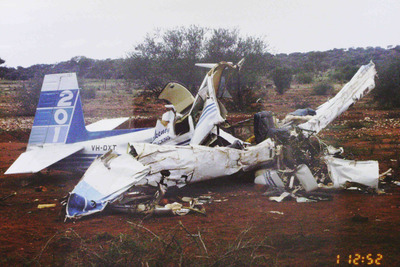Aviation ELTs don’t always activate
An Australian Transport Safety Bureau has shown that aviation emergency locator transmitters work only 40 to 60% of the time.
Emergency locator transmitters (ELTs) are carried on most aircraft so that in the event of an accident in a remote location, the aircraft wreckage and its occupants can be located quickly by search and rescue (SAR) operations. Finding the aircraft wreckage quickly not only increases the chance of survival of the occupants, but also reduces the risk to pilots of SAR aircraft who commonly need to operate in marginal weather conditions and over mountainous terrain.
Airframe-mounted ELTs are designed to automatically activate following an impact typical of a collision. However, the effectiveness of airframe ELTs in aviation accidents has been questioned for some time by accident investigation agencies and by the aviation community. Beyond individual examples of ELTs not activating following an accident, there has been little research done to date to review how reliably ELTs operate as designed after an aircraft accident.
In a new research investigation, the Australian Transport Safety Bureau (ATSB) has identified safety concerns regarding the operation of ELTs and presents data on the effectiveness of ELTs activating following an accident.
Not working as expected
Data from the ATSB database show that ELTs function as intended in about 40 to 60% of accidents in which their activation was expected.
Records of the Australian Maritime Safety Authority’s SAR incidents show that search and rescue personnel were alerted to aviation emergencies in a variety ways including radio calls and phone calls, and that ELT activation accounted for the first notification in only about 15% of incidents. However, these ELT activations have been directly responsible for saving an average of four lives per year.

In accidents where ELTs did not work effectively (or at all), it was found that their performance could be affected by:
- not selecting the ELT activation before flight;
- incorrect installation;
- flat batteries;
- lack of waterproofing;
- lack of fire protection;
- disconnection of the co-axial antenna cable from the unit during impact;
- damage and/or removal of the antenna during impact;
- an aircraft coming to rest inverted after impact.
Steps to safety
Pilots and operators of general aviation and low-capacity aircraft need to be aware that a fixed fuselage-mounted ELT cannot be relied on to function in the types of accidents in which they were intended to be useful.
The effectiveness of ELTs in increasing occupant safety and assisting SAR efforts may be enhanced by using a GPS-enabled ELT, using an ELT with a newer 3-axis g-switch, ensuring it is installed correctly, ensuring the beacon is registered with AMSA and pre-emptively activating the beacon if a forced landing or ditching is imminent.
Additionally, carrying a personal locator beacon (PLB) in place of or as well as a fixed ELT will most likely only be beneficial to safety if it is carried on the person, rather than being fixed or stowed elsewhere in the aircraft.
The report is available at: http://www.atsb.gov.au/publications/2012/ar-2012-128.aspx.
Why P25 technology remains a good fit for public safety communications
Digital LMR technology ensures police officers, firefighters and emergency management teams can...
From past to present: leveraging satellite data for better disaster resilience
Whether monitoring flood-prone regions or assessing wildfire-prone landscapes, historical...
Lancashire Police adds in-car video to full vehicle fleet
Motorola Solutions' M500 in-car video solution observes a vehicle's environment from...





